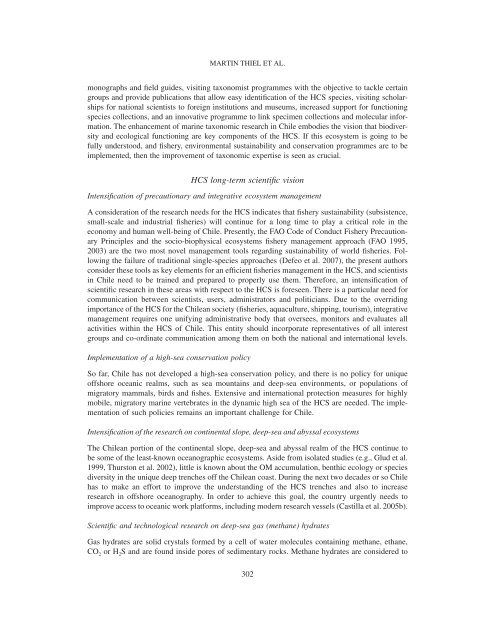the humboldt current system of northern and central chile - figema
the humboldt current system of northern and central chile - figema
the humboldt current system of northern and central chile - figema
Create successful ePaper yourself
Turn your PDF publications into a flip-book with our unique Google optimized e-Paper software.
MARTIN THIEL ET AL.monographs <strong>and</strong> field guides, visiting taxonomist programmes with <strong>the</strong> objective to tackle certaingroups <strong>and</strong> provide publications that allow easy identification <strong>of</strong> <strong>the</strong> HCS species, visiting scholarshipsfor national scientists to foreign institutions <strong>and</strong> museums, increased support for functioningspecies collections, <strong>and</strong> an innovative programme to link specimen collections <strong>and</strong> molecular information.The enhancement <strong>of</strong> marine taxonomic research in Chile embodies <strong>the</strong> vision that biodiversity<strong>and</strong> ecological functioning are key components <strong>of</strong> <strong>the</strong> HCS. If this eco<strong>system</strong> is going to befully understood, <strong>and</strong> fishery, environmental sustainability <strong>and</strong> conservation programmes are to beimplemented, <strong>the</strong>n <strong>the</strong> improvement <strong>of</strong> taxonomic expertise is seen as crucial.HCS long-term scientific visionIntensification <strong>of</strong> precautionary <strong>and</strong> integrative eco<strong>system</strong> managementA consideration <strong>of</strong> <strong>the</strong> research needs for <strong>the</strong> HCS indicates that fishery sustainability (subsistence,small-scale <strong>and</strong> industrial fisheries) will continue for a long time to play a critical role in <strong>the</strong>economy <strong>and</strong> human well-being <strong>of</strong> Chile. Presently, <strong>the</strong> FAO Code <strong>of</strong> Conduct Fishery PrecautionaryPrinciples <strong>and</strong> <strong>the</strong> socio-biophysical eco<strong>system</strong>s fishery management approach (FAO 1995,2003) are <strong>the</strong> two most novel management tools regarding sustainability <strong>of</strong> world fisheries. Following<strong>the</strong> failure <strong>of</strong> traditional single-species approaches (Defeo et al. 2007), <strong>the</strong> present authorsconsider <strong>the</strong>se tools as key elements for an efficient fisheries management in <strong>the</strong> HCS, <strong>and</strong> scientistsin Chile need to be trained <strong>and</strong> prepared to properly use <strong>the</strong>m. Therefore, an intensification <strong>of</strong>scientific research in <strong>the</strong>se areas with respect to <strong>the</strong> HCS is foreseen. There is a particular need forcommunication between scientists, users, administrators <strong>and</strong> politicians. Due to <strong>the</strong> overridingimportance <strong>of</strong> <strong>the</strong> HCS for <strong>the</strong> Chilean society (fisheries, aquaculture, shipping, tourism), integrativemanagement requires one unifying administrative body that oversees, monitors <strong>and</strong> evaluates allactivities within <strong>the</strong> HCS <strong>of</strong> Chile. This entity should incorporate representatives <strong>of</strong> all interestgroups <strong>and</strong> co-ordinate communication among <strong>the</strong>m on both <strong>the</strong> national <strong>and</strong> international levels.Implementation <strong>of</strong> a high-sea conservation policySo far, Chile has not developed a high-sea conservation policy, <strong>and</strong> <strong>the</strong>re is no policy for unique<strong>of</strong>fshore oceanic realms, such as sea mountains <strong>and</strong> deep-sea environments, or populations <strong>of</strong>migratory mammals, birds <strong>and</strong> fishes. Extensive <strong>and</strong> international protection measures for highlymobile, migratory marine vertebrates in <strong>the</strong> dynamic high sea <strong>of</strong> <strong>the</strong> HCS are needed. The implementation<strong>of</strong> such policies remains an important challenge for Chile.Intensification <strong>of</strong> <strong>the</strong> research on continental slope, deep-sea <strong>and</strong> abyssal eco<strong>system</strong>sThe Chilean portion <strong>of</strong> <strong>the</strong> continental slope, deep-sea <strong>and</strong> abyssal realm <strong>of</strong> <strong>the</strong> HCS continue tobe some <strong>of</strong> <strong>the</strong> least-known oceanographic eco<strong>system</strong>s. Aside from isolated studies (e.g., Glud et al.1999, Thurston et al. 2002), little is known about <strong>the</strong> OM accumulation, benthic ecology or speciesdiversity in <strong>the</strong> unique deep trenches <strong>of</strong>f <strong>the</strong> Chilean coast. During <strong>the</strong> next two decades or so Chilehas to make an effort to improve <strong>the</strong> underst<strong>and</strong>ing <strong>of</strong> <strong>the</strong> HCS trenches <strong>and</strong> also to increaseresearch in <strong>of</strong>fshore oceanography. In order to achieve this goal, <strong>the</strong> country urgently needs toimprove access to oceanic work platforms, including modern research vessels (Castilla et al. 2005b).Scientific <strong>and</strong> technological research on deep-sea gas (methane) hydratesGas hydrates are solid crystals formed by a cell <strong>of</strong> water molecules containing methane, ethane,CO 2 or H 2 S <strong>and</strong> are found inside pores <strong>of</strong> sedimentary rocks. Methane hydrates are considered to302










